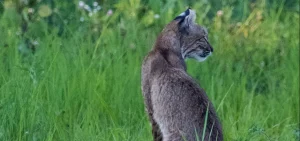News
A bobcat spotted in Greene County is the latest sign of an Ohio comeback
By: Adriana Martinez-Smiley | WYSO
Posted on:
FAIRBORN, Ohio (WYSO) — There was a rare bobcat sighting in Fairborn late last month. There have only been a handful of modern sightings of bobcats in Greene County — 11 to be exact.

“We’ve really seen that in a relatively short time – 20 to 30 years – an increase from very few resident bobcats to a very well-established bobcat population in southeast and southern Ohio,” she said. “And that’s still continuing to expand, into your area there in southwest Ohio.”
In Greene County, Ohio Department of Natural Resources didn’t receive its first report of a modern bobcat sighting until 2020.
Allen McGrew, a geology professor at the University of Dayton and a member of the Beaver Creek Wetlands Association, was the one that made the recent sighting and reported it to the the state. McGrew said he was on a walk around Beerman Fen, which is one of the association’s properties, when he noticed the feline with enough time to snap a photo of it.
He said bobcats are top of the food chain, so it’s a sign that prey animals must be flourishing as well.
“I know it’s really special for the volunteers who have worked so hard to preserve this corridor and to create a space that can be welcoming a broader sense of community, where we humans can come in, but we can hold it in common with the natural world too,” McGrew said.
Based on a 2015 study on recovering bobcat populations in Ohio, rabbits, deer, as well as large rodents make up a majority of the bobcat diet.
Dennison said humans should be fairly safe around bobcats, but they should be wary on behalf of their smaller pets.
“So, as with any wildlife, you certainly want to keep your distance if you see them, and not interfere with them. But generally, bobcats tend to be more afraid of us than we are of them. Most of the time, once they figure out you’re there, they’re just going to take off,” she said.
Dennison said bobcats prefer more natural areas to inhabit, but this bobcat was found only a few hundred feet from restaurants and within a quarter mile of Interstate 675.

